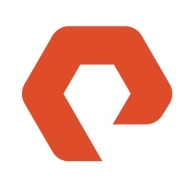


NetApp AFF and Nutanix Unified Storage (NUS) are leading storage solutions competing in the enterprise storage category. Nutanix NUS seems to have the upper hand due to its scalability and integrated features, although its higher price point should be considered.
Features: NetApp AFF offers robust performance with high-speed data access, comprehensive data management capabilities, and reliable performance. Nutanix NUS features an all-in-one infrastructure, seamless scalability, and enhanced data protection features. Users find Nutanix easier to integrate with other systems and more flexible for diverse business environments.
Room for Improvement: NetApp AFF users note the complexity of the configuration process, the need for better documentation, and a steep learning curve. Nutanix NUS users suggest that support response times need improvement and that more advanced analytics features are required. Additionally, Nutanix could further enhance its user interface for better usability.
Ease of Deployment and Customer Service: NetApp AFF deployment is straightforward but complex due to extensive configuration requirements. Its customer service is responsive and helpful. Nutanix NUS offers a simpler deployment process with less initial configuration, though feedback indicates that customer service response times could be faster.
Pricing and ROI: NetApp AFF users feel that initial setup costs are high but report significant long-term ROI due to performance reliability. Nutanix NUS users also find the setup costly but believe the seamless scaling and feature-rich offerings justify the investment, leading to high ROI over time.
By opting for the gold subscription every three years, you get a free upgrade to the latest controller release.
If you wait more than seven years to buy another one, you get a return on your investment.
For me, the biggest return on investment when using this solution is that we do not have to have much support staff to run it.
The scalability challenge with previous systems is lessened with Nutanix since we can expand by adding new hardware without needing migrations.
We are saving approximately 20% to 25% compared with the competition.
We also had one outage where a controller of one of the products had failed and had to be replaced on-site.
Customers always have their issues resolved promptly.
Technical support is good at least through vendors, not directly with the principal.
The support for NetApp AFF is comprehensive—not just the documentation for self-guided reading, but for simple questions, spare parts, or urgent needs, you can have a contract that enables delivery the next business day or within four hours, depending on your process requirements.
I have communicated with them, and they are effective and responsive.
They come on the call, start troubleshooting immediately, and resolve issues effectively.
They are very knowledgeable, and if they can't solve the problem, they find the answer within a day or so.
I would give the customer service and technical support a ten out of ten.
It is highly scalable.
It is suitable for both medium-sized and enterprise businesses.
It hasn't broken down anytime in the last six to seven years, despite hurricanes, earthquakes, and power outages.
You can add more disks, more disk shelves, or migrate the data seamlessly.
I would assess the scalability of NetApp AFF as excellent in handling massive data volumes.
This means you don't have to buy everything upfront; you can buy what you need and add more as you grow, which is advantageous.
These three components utilize scalability tools, enabling storage addition to nodes and supporting independent, linear performance growth.
I find the scalability of Nutanix Unified Storage (NUS) to be excellent, and I would rate it a ten based on my clients' requirements.
I would rate the stability of the solution as a ten out of ten.
I would rate the stability of the product at seven out of ten.
They have always been upgrading very fast and implementing patches to resolve these issues.
We have not experienced these issues with Nutanix, which I attribute to the all-flash technology, the quality of their platform, and the responsiveness of the hyper-converged infrastructure.
Nutanix Unified Storage (NUS) is very stable.
It automatically triggers tasks, causing performance issues.
We would appreciate a built-in transparent failover in the next release to eliminate the need for a separate metro cluster.
I'm eagerly anticipating the roadmap's promise of introducing multiple controllers, which could significantly boost scalability and resilience.
We mostly rely on long-term releases. We don't need the most up-to-date features, but we need a reliable environment.
The GUI of ONTAP Command Manager could be better, but the CLI is perfect.
Our backup system, Commvault, has an amazing capacity to do compression and deduplication better than NetApp AFF by itself.
The main concern is pricing, which could deter some customers; addressing this would enhance its appeal.
The system should move towards AI-driven optimization and enhance S3 object storage capabilities.
System downtime can disturb the entire ecosystem and impact all applications.
While the prices may be higher than those of other vendors, we see it as a market leader with benefits.
The support can be a bit pricey, but the solution is more cost-effective than anything else out there.
I would give it a nine out of ten in terms of costliness.
NetApp support is cheaper than Dell support.
While it is not cheap, they have introduced a new series of AFF that are more affordable.
The licensing cost of the product is expensive, and when combined with support, it becomes quite costly.
Compared to buying three or four vendor solutions, it is much cheaper.
The cost has doubled for the same amount of data, which was a challenge when presenting use case justifications for the increased cost.
Nutanix Unified Storage (NUS) has definitely helped reduce our total cost of ownership.
The platform's robust features include excellent sustainability tracking, and a comprehensive dashboard offering insights into IOPS, bandwidth, performance, and virtual activities.
Its data compression feature is the best that we have ever seen.
The standout features for us in Pure FlashArray X NVMe are its robust DDoS protection, seamless transparent failover, and failback capabilities ensuring high availability.
You can even download the ONTAP simulator and deploy it on your virtualization platform and test almost all features.
Data reduction capabilities such as deduplication, compression, and compaction are standard features included with the license in NetApp AFF.
Two important features that NetApp AFF has are the performance and the capacity to save data against attacks in general or hardware failure.
Nutanix Unified Storage (NUS) is appreciated for its fault tolerance and redundancy at the cluster level, which ensures reliable storage of files, folders, and other information accessible on the client side.
The cybersecurity features of Nutanix Unified Storage (NUS) when dealing with unstructured data, such as ransomware threats, provide the ability to detect and back up block-based storage, allowing me to restore repositories or sets of block storage with one button click, which is automatic.
My experience with using Nutanix Unified Storage (NUS) for data-intensive workloads is that we have many SQL Servers and they perform much better than they did when we used hybrid converged previously.
| Product | Market Share (%) |
|---|---|
| NetApp AFF | 9.4% |
| Nutanix Unified Storage (NUS) | 0.7% |
| Pure FlashArray X NVMe | 1.1% |
| Other | 88.8% |



| Company Size | Count |
|---|---|
| Small Business | 15 |
| Midsize Enterprise | 11 |
| Large Enterprise | 12 |
| Company Size | Count |
|---|---|
| Small Business | 44 |
| Midsize Enterprise | 46 |
| Large Enterprise | 242 |
| Company Size | Count |
|---|---|
| Small Business | 27 |
| Midsize Enterprise | 30 |
| Large Enterprise | 63 |
Pure Storage FlashArray//X is the world’s first enterprise-class, all-NVMe flash storage array. It represents a new class of storage – shared accelerated storage, which is a term coined by Gartner – that delivers major breakthroughs in performance, simplicity, and consolidation.
The NetApp A-Series and C-Series are AFF storage arrays that deliver high performance, scalability, and simplified data management for a wide range of workloads. They are designed for organizations that need to improve the performance and agility of their applications, while also reducing costs and complexity.
NetApp A-Series and C-Series feature a scale-out architecture that can be scaled to meet the needs of your growing business. They also support a wide range of built-in data protection and data security features, including snapshots, replication, disaster recovery, and autonomous ransomware protection.
AFF A-Series all-flash systems deliver industry-leading performance, density, scalability, security, and network connectivity.
AFF C-Series systems are suited for large-capacity deployment as an affordable way to modernize your data center to all flash and also connect to the cloud.
NetApp AFF Benefits
NetApp AFF Features
Reviews from Real Users
NetApp AFF stands out among its competitors for a number of reasons. Two major ones are its high performance and simplicity. PeerSpot users take note of the advantages of these features in their reviews:
PeerSpot user and Storage Administrator, Daniel Rúnar Friðþjófsson, comments “AFF has helped to simplify our infrastructure, while still getting very high performance for our business-critical applications. Having all these things working well on one solution is really good. We run this as the backbone for both Hyper-V and VMware as well as an archive location for Rubrik. So, it is great having one solution that can do it all.
Because of the ease of it all, you have a highly tunable, high-performance storage system that alleviates a lot of problems. With its ease of management, you can quickly get your work done and go onto the next thing on your list.”
Additionally, Mohan Reddy, Sr. Technology Architect at a Pharma/Biotech company comments on how “NetApp's ONTAP data management software has also made tasks simpler for us. There's no question about that. It has helped us run operations very quickly, saving us a lot of time. Before ONTAP, we used to spend a long time doing regular operations, but with the latest version of the tool, our day-to-day operations are much quicker and easier.”
Nutanix Unified Storage provides high availability and seamless cloud platform integration, ensuring robust redundancy, scalability, and streamlined management. It supports hybrid cloud connectivity, enhancing storage security and performance.
Nutanix Unified Storage is designed for effective data protection across block, file, and object storage, offering features like ransomware detection and a centralized management interface through Prism Central. Users gain improved SLAs and IT cost savings through its efficient performance. Despite its user-friendly interface, there is a demand for enhanced security measures such as Multi-Factor Authentication and DLP. While its resilience is notable, users seek improvements in protocol compatibility, storage capabilities, pricing, and support processes.
What are the most important features of Nutanix Unified Storage?Industries implement Nutanix Unified Storage for tasks such as file storage, database performance improvement, and storage solution consolidation. Companies deploying virtual machines, securing against ransomware, connecting hybrid clouds, and backing up data find it useful. It supports workloads like Citrix VDI, Kubernetes, and research data, assisting many organizations migrating from legacy storage for better cost efficiency and reduced data center footprints.
We monitor all All-Flash Storage reviews to prevent fraudulent reviews and keep review quality high. We do not post reviews by company employees or direct competitors. We validate each review for authenticity via cross-reference with LinkedIn, and personal follow-up with the reviewer when necessary.